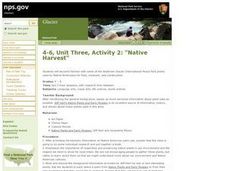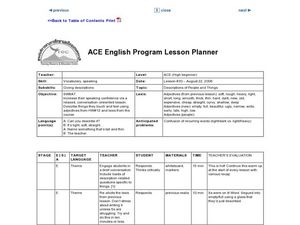New York City Department of Education
Geography and Early Peoples of the Western Hemisphere
Young historians discover the early people of the western hemisphere. The unit explores how the land changed, how it was used and homes of early Americans such as Incas, Mayans, Inuits, Aztecs, and Pueblos. Individuals also examine these...
Curated OER
Writing Exercises: Early Peoples
Human prehistory is an exciting topic for many learners! Engage your social studies class in critical thinking by having them answer the three short essay questions on this worksheet. They need to know why prehistoric people migrate, how...
Curated OER
The Early Peoples
Young scholars, after studying The Early Peoples, explain and give examples of how Native Americans and Europeans adapted to living in certain environments. They give examples of early cultures and settlements that existed in North...
Curated OER
Rights in Early America
Get your historians to hop into someone else's 18th century shoes with a simulation on rights in early America. Each individual gets an identity card, indicating their race, gender, and status (slave or free). Areas around the room are...
Curated OER
Louisiana History-Unit 4: Early People of Louisiana and a Meeting of Different Worlds
The Poverty Point Culture of Louisiana is described in detail within four slides of this six-slide PowerPoint. Four detailed paragraphs help describe the economic legacy that existed in Louisiana. A table, map, and photo are included to...
Curated OER
Then and Now: Life in Early America, 1740 - 1840
Young scholars complete a unit of lessons that examine life in early America from 1740-1840. They compare items with similar objects we use today, explore various websites, create a paper doll, try and guess the function of various...
Curated OER
Sticks, Stones, Sinews and Stuff: How Early People Used the Environment to Meet Basic Needs
Students create an artifact. In this early survival lesson, students use found objects to create an artifact that could have been used to help early people meet their basic needs.
Curated OER
Native Harvest
Students read Native Plants and Early Peoples and explore the plants in Waterton-Glacier International Peace Park and find how the Native Americans used them. In this Native American plant and people lesson, students research two types...
Curated OER
Early American English Lit Writing Assignment (Senior, Literature)
To better understand early American literature, which was usually written by Puritans coming to the new world, learners pretend they have just landed on Mars. They compose a letter home describing their experiences, the new landscape,...
Curated OER
Warm Up: When Modern Human Behavior Appeared in Early Hominids
Upper graders or entry college level learners use the provided article links to answer three questions regarding early modern human behavior. They compose short essay responses that accommodate each part of the overarching question,...
Curated OER
The Early 19c: The Creation of an American Culture
Full of good information and photos from the 1700's to the 2004 election, this powerpoint could be a great resource in a lecture about American nationalism. While the slides require commentary and smooth transitions (as well as a little...
Curated OER
PEOPLE OF THE STONE AGE
Sixth graders summarize how early people interacted to meet basic human needs. They observe how increased numbers of people and the search for food led to migration. Students analyze how the interactions among people led to the...
Americans All
A Simulation: The Peopling of America
What was it like to pass through Ellis Island? Learners move through the immigration process of the early 1900s in a simulation activity. A comprehensive activity includes role-playing profiles and other manipulative items such as...
Curated OER
We the People Level 2
Students explore U.S. history by participating in a government activity. In this Constitution lesson plan, students identify the role government plays in our society and the differences the British colonies had in the early 18th century....
Curated OER
Early America: Jeopardy Game
Fifth graders can put their knowledge of early American life, the 13 colonies, and maps to the test when they play this Jeopardy game. The game covers terminology, famous people, and geography related to Colonial American times. Note:...
Core Knowledge Foundation
Early World Civilizations Tell It Again!™ Read-Aloud Anthology
Ancient world civilizations are the focus of a read-aloud anthology. First graders explore the early world of Mesopotamia, Babylon, the sphinx, and pyramids, get to know people of the Nile, Hatshepsut, and Tutankhamun, and examine world...
Carolina K-12
Early American Settlements
What brought settlers from Europe to North America? By exploring primary sources, such as posters seeking recruits for the new lands, class members take a deeper look at these motivations. To finish, they present their findings to...
Curated OER
Collecting Data to Learn About the People Around You
Human graphs, anyone? Did you eat fruit today? What is your favorite costume? Have your K – 6 learners graph the responses. Early elementary grades may count and compare while upper grades compare responses of different groups or make...
North Carolina School of Science and Mathematics
Henry Kissinger and Detente
How did relations between the United States and the People's Republic of China evolve between 1950 and 1970? Your young historians will complete a timeline of events with evidence that the relationship between these two great nations was...
Curated OER
Description of People and Things
Elementary schoolers use adjectives correctly in their speech. They demonstrate adjectives using familiar objects. (For example, they might show narrow by walking between two chairs placed closely together.) Then they play antonym Bingo...
Chicago Historical Society
Are We the People?
Taking on the roles of a fiery Boston patriot, a Philadelphia merchant's wife, and a prominent abolitionist, your young historians will consider the reactions of these early Americans to the creation of the Declaration of Independence,...
Curated OER
Early Russian History
While not heavy in text, the vivid images, maps, and key information in this slide show, are sure to hold an audience. They'll view images of geography, buildings, and people who are apart of early Russian History. Use the presentation...
TCI
Picking Rusty Gold: Why Do People Buy and Sell Antiques?
Your historical sleuths will work to research the in-depth history of chosen artifacts and will use their research to design a fictional advertisement for an early 20th century item.
Curated OER
Life Grid: First Ladies Early Lives
While the resource won't seem like much at first glance, it could actually prove to be very handy. Learners fill in a grid that contains life facts on the Y-axis and the names of first ladies on the X-axis. Great for documenting facts...

























